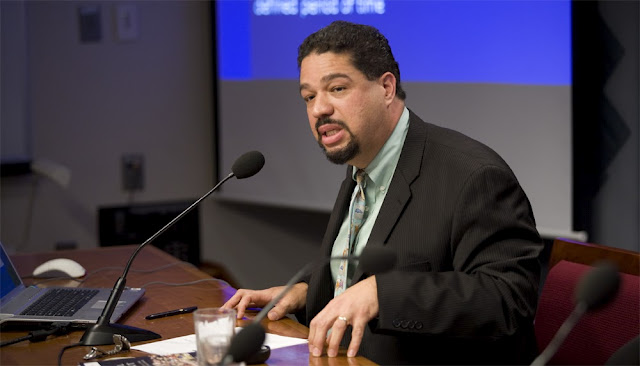Showing posts from category development.
-
Assessing Our Impact on the World’s Rivers
› In a special “Rivers in Crisis” issue of Nature, the lead article, “Global Threats to Human Water Security and River Biodiversity,” presents damning evidence that manipulation of river systems — through the construction of canals, levees, hydroelectric projects, and other infrastructure — has caused serious and lasting biological damage to watersheds throughout both the developing and developed worlds. The authors (all 11 of them!) report that key rivers have become shadows of their former selves in terms of the amount of aquatic life they can support. Without drastically improved stewardship of waterways, “we are pushing these river systems toward catastrophe,” warns Peter McIntyre, an article co-author.
In a special “Rivers in Crisis” issue of Nature, the lead article, “Global Threats to Human Water Security and River Biodiversity,” presents damning evidence that manipulation of river systems — through the construction of canals, levees, hydroelectric projects, and other infrastructure — has caused serious and lasting biological damage to watersheds throughout both the developing and developed worlds. The authors (all 11 of them!) report that key rivers have become shadows of their former selves in terms of the amount of aquatic life they can support. Without drastically improved stewardship of waterways, “we are pushing these river systems toward catastrophe,” warns Peter McIntyre, an article co-author. The human impact on the world’s river systems will be hard to reverse, says Margaret Palmer, author of a second Nature article on freshwater biodiversity loss, “Beyond Infrastructure.” Human-induced changes to watersheds affect local hydrology at a fundamental level, she contends, weakening rivers’ ability to deliver crucial “ecological goods and services” — such as clean water and nutrient-rich sediment loads — that help maintain the health of local environments and the human populations that depend on them. To fully understand the scope of the problem, Palmer says more research is needed to explore the linkages between biodiversity levels and “ecosystem services” that healthy rivers provide.
The human impact on the world’s river systems will be hard to reverse, says Margaret Palmer, author of a second Nature article on freshwater biodiversity loss, “Beyond Infrastructure.” Human-induced changes to watersheds affect local hydrology at a fundamental level, she contends, weakening rivers’ ability to deliver crucial “ecological goods and services” — such as clean water and nutrient-rich sediment loads — that help maintain the health of local environments and the human populations that depend on them. To fully understand the scope of the problem, Palmer says more research is needed to explore the linkages between biodiversity levels and “ecosystem services” that healthy rivers provide. -
Barbara Crossette on UNFPA State of the World Population 2010 Report
› “Particularly when you go into a society that’s been broken by war or conflict or is so impoverished that is has nowhere to start climbing up, there have to be integrated programs and they have to work with people in mind,” said former New York Times foreign correspondent Barbara Crossette in an interview with The New Security Beat. “The people themselves will solve a lot of the problems around them if they’re just given the tools to do so.”
“Particularly when you go into a society that’s been broken by war or conflict or is so impoverished that is has nowhere to start climbing up, there have to be integrated programs and they have to work with people in mind,” said former New York Times foreign correspondent Barbara Crossette in an interview with The New Security Beat. “The people themselves will solve a lot of the problems around them if they’re just given the tools to do so.”
Crossette is one of the lead authors of the UN Population Fund’s latest State of the World Population Report, “From Conflict and Crisis to Renewal: Generations of Change,” set to launch this Wednesday, October 20th. She spoke to us particularly about the challenges of women around the world and the unique storytelling aspect of this year’s report.
The “Pop Audio” series offers brief clips from ECSP’s conversations with experts around the world, sharing analysis and promoting dialogue on population-related issues. Also available on iTunes. -
Gayle Tzemach Lemmon, Council on Foreign Relations
MDGs for Women Largely Unmet
›October 15, 2010 // By Wilson Center Staff
Excerpt from a First Take by Gayle Tzemach Lemmon at the Council on Foreign Relations:
Ten years after global leaders vowed to work toward eradicating extreme poverty, achieving universal primary education, reducing child mortality, and more, the eight Millennium Development Goals (MDGs) – particularly those relating to women – remain a distant hope. Though women were a focus of much discussion this week at the MDG summit in New York, the forward movement so far has been discouraging on the two MDGs directly relating to women: “promoting gender equality and empowering women” and “reducing by three-quarters the maternal mortality ratio.”
An MDG report released in June noted that when it comes to women, “progress has been sluggish on all fronts – from education to access to political decision-making.”While progress has been made on girls’ primary school enrollment, only three of ten regions are on track regarding women’s share of paid employment. The figure is even bleaker concerning women’s equal representation in national parliaments.
Data is still being collected, but early figures show the maternal mortality ratio reduction rate is “well short” of the 5.5 percent annual decline required to slash global maternal mortality by the MDGs’ stated 75 percent. Data from 1990 shows 430 maternal deaths per one hundred thousand live births. As of 2008, that figure had dropped only slightly to four hundred deaths per one hundred thousand live births, nowhere near the goal of below 150.
Continue reading at the Council on Foreign Relations.
Photo Credit: Adapted from “Untitled,” courtesy of flickr user :Bron:. -
Welcome Back, Roger-Mark: A Powerful Voice Returns to PHE
›October 13, 2010 // By Geoffrey D. Dabelko“I’m thrilled to be back.” That was the sentiment that Roger-Mark De Souza relayed to me, in his famous lilting baritone, about becoming the new vice president of research and director of the climate program at Population Action International (PAI). De Souza has long been a leading voice on integrated development programs that feature population, health, and environmental (PHE) dimensions. But three years as the Sierra Club’s director of foundations and corporate relations took him away from day-to-day work on these issues.
In his new posts, Roger-Mark will lead PAI’s research team in establishing a strong evidence base and engaging new allies in the effort to support healthier women and families, according to PAI. “Roger-Mark’s diverse research experience makes him an ideal fit for PAI as we undertake critical projects on reproductive health, population and environment issues,” said PAI President and CEO Suzanne Ehlers in a press release.PAI is a research-based advocacy NGO long known for innovative work connecting demographic considerations with other key development realms: mainly environment, security, and poverty. PAI’s policy-friendly briefs on population’s links with water, forests, and biodiversity provide practical meta-analysis of these complex and evolving connections. The organization’s more recent work on demographic security has been instrumental in advancing research and policy in that largely neglected arena.
De Souza captured his insights last year for our Focus series, in his brief, “The Integration Imperative – How to Improve Development Programs by Linking Population, Health, and Environment” (see also his follow-up interview on NSB). He combines lessons learned from community-based development efforts in Southeast Asia and East Africa with a savvy sense of the policy debates among donors and recipient countries alike.
This move reunites De Souza with Kathleen Mogelgaard, with whom he made key contributions to the PHE field as colleagues at Population Reference Bureau earlier this decade, and who is now Senior Advisor for Population, Gender, and Climate at PAI.
De Souza returns to his former focus on PHE issues at a time when the field is collectively searching for the best ways to respond to the challenges of climate mitigation and adaptation, as well as ongoing hurdles such as scaling up, sustainability, and labeling. -
The “Condom King” speaks at TEDxChange on Poverty Reduction and a “9th MDG”
›“We have now found the weapon of mass protection,” said Mechai Viravaidya (a.k.a. the “Condom King”) at the recent TEDxChange event in New York. Viravaidya is the founder and chairman of the Population and Community Development Association and a former senator of Thailand. He spoke about his innovative approaches to addressing Thailand’s once high rates of poverty, child mortality, and HIV through the promotion of family planning and condom use.
-
Rare Earths Wake-Up, Aid Shocks, and the “Securitization” Distraction
›October 8, 2010 // By Geoffrey D. DabelkoHere are some useful links to environment, population, and security work that recently crossed my desk.
• China’s willingness to cut exports of rare earth elements to Japan over its East China Sea dispute woke up the larger world to the heavy dependency on China for supplying these key inputs into the modern (and green, in particular) industrial economy. Chinese attempts to take back their shot across the bow are bound to fail, as illustrated by U.S. Commerce Secretary Gary Locke’s call for the G20 to guarantee rare earth access, Wednesday at the Wilson Center.
• The National Geographic headline, “Replacing Oil Addiction With Metals Dependence?” raises another key long-term question, explored in detail on NSB in several previous posts.• “Aid Shocks Likely Cause Armed Conflict,” is the provocative title on a post from the new blog AidData. The post summarizes a forthcoming scholarly piece in the American Political Science Review that suggests cutting-off foreign assistance (what the author team calls an “aid shock”) significantly increases the likelihood of violent conflict.
• Dan Smith, Secretary-General of the UK-based NGO International Alert, has multiple nuggets in his latest riff, “From the UK gov’t, a good message on development and peace.” Like the Global Dashboard post I mentioned last week, Smith uses the recent speech by UK Development Secretary Andrew Mitchell as his foil. The MDGs aren’t the sum total of development and a new narrative is needed. “Securitization” is a distraction that should be put to rest, and integration and focus on conflict-affected countries are the centerpiece of a welcome new narrative coming out of London.
• Finally, Wilson Center President and Director Lee Hamilton is stepping down this fall after twelve years heading the Center. His time at the Center comes after 34 years as a Congressman from Indiana. Lee’s departure has engendered numerous profiles; this one in Foreign Policy is one of the best. -
Google Data Maps Development Indicators
›If you have not had the (purely wonky) pleasure of playing with Google’s Public Data Explorer, do yourself a favor and direct your browser there now.
Born from Hans Rosling’s Gapminder, Google’s data explorer currently allows the user to choose from 24 different data sets, including information from the World Bank, U.S. Census Bureau, Eurostat, and Energy Information Agency. Users can then customize the dataset’s variables, save their work, and even embed the resulting chart, “unveiling the beauty of statistics for a fact-based world view,” as the Gapminder site puts it.
The example dataset above uses development indicators from the World Bank to show areas of the world where high fertility rate and heavy reliance on subsistence agriculture have persisted over time. It’s worth noting that many of the countries in the upper right of the graph are also where we find persistent conflict, and, if one accepts the predictions that Africa will see some of the most profound effects of climate change, they also face real risk of continuing instability as declining crop yields threaten livelihoods and population growth continues. -
India’s Threat From Within
›Once a modest pro-peasant movement, India’s Maoist (or Naxalite) insurgency has become what New Delhi describes as the nation’s biggest internal security threat. The insurgency has spread to 20 of India’s 29 states, and across more than a third of the country’s 626 districts, most of them in the impoverished east. Earlier this summer, the Woodrow Wilson Center’s Asia Program, with assistance from the Environmental Change and Security Program, hosted, “The ‘Gravest Threat’ to Internal Security: India’s Maoist Insurgency,” to examine the insurgency’s main drivers, identify its prime tactics and strategies, and consider the best ways to respond.
Same Insurgency, Different Motivations
P.V. Ramana, a research fellow at the New Delhi-based Institute for Defense Studies and Analyses, discussed the motivations that draw people to the insurgency. Some people are aggrieved by the resource exploitations they witness in their villages. Others join the Maoist cause because of the “high-handedness” of Indian security forces. Still others do so because family members are already in the movement.
Ramana underscored a “serious disconnect” at play — people have such varied reasons for joining the insurgency, yet top Maoist leaders are inspired by one sole motivation: capturing political power. Ramana also highlighted the “increasing militarization” of the insurgency. Maoists have amassed an immense arsenal of weaponry, from “crude” tools to more sophisticated weapons such as rocket launchers and landmines. Their attacks increasingly target not only government security forces, but also national infrastructure such as power lines and railways.
Andhra Pradesh: Leading By Example
K. Srinivas Reddy, a Hyderabad-based deputy editor for The Hindu, offered a case study of the insurgency in his home state, Andhra Pradesh (AP), in southeastern India. He noted that New Delhi’s response to the insurgency in AP is often cited as a success story. This response, according to Reddy, can be attributed to an “attitudinal change” within the security ranks. From the 1970s through the mid-1990s — a period of mass Maoist recruitment and escalating insurgent violence — New Delhi’s counterinsurgency measures had been “panicky,” haphazard, and reactive, Reddy said. The “turning point” came in 1996, when a new “unity of thought” emerged within the government that emphasized better training of security forces, stronger intelligence, and greater attention to economic development. Later in the 1990s, security forces further softened their strategies and tactics, emphasizing “problem-solving rather than hunting Naxals.” As a result, in the early 2000s, popular support for Maoists in AP began to wane.
Is the Government Also to Blame?
Nandini Sundar, a professor of sociology at Delhi University, focused on the human impact of both the insurgency and the government’s response. Much of her presentation centered around Bastar, a sparsely populated, heavily forested, mineral-rich district of Chhattisgarh state — one of the areas hardest-hit by the insurgency. Maoist “entrenchment” is strong, she argued, because locals are treated so dreadfully by the government. “Very poor people are jailed” for committing minor forestry transgressions, Sundar explained, while “powerful people” get away with large-scale offenses. Additionally, the police are deeply unpopular and “a source of repression.” They also regularly rape women and extort money, she said.
Sundar identified and condemned a raft of repressive government policies — from throwing locals off their land to commandeering schools — and insisted that such repression constitutes the prime reason for recruitment to the insurgency. “Injustice more than inequality” explains why people join the Maoists, she said.
The panel was far from sanguine about the future. Ramana contended that immediate prospects for peace talks between the government and the Maoists are slim, and that civil society has been “quiet” and has offered little assistance. While he predicted that some sort of resolution could be reached in “7 to 10 years,” Sundar countered that the harsh nature of New Delhi’s response means that 7 to 10 years “could finish off” not just the Maoists, but also village populations.
Compounding the challenge is what Sundar described as “official contempt” toward the culture of the Adivasi, the tribal peoples of India whose homeland comprises the insurgency’s epicenter. Dehumanizing, anti-adivasi language from the government enables New Delhi to justify the waging of forceful counterinsurgency, Sundar argued.
Glimmers of Hope
Several speakers, however, gave reasons to be guardedly optimistic about the Maoist issue. Pointing to Maoist strategies in Andhra Pradesh, Reddy suggested that the insurgency’s poor policies could spell its demise. Maoists in this state chose to escalate violence, but their inability to spread their ideology along with this violence has cost them public support, particularly in urban areas. (A recent survey by The Times of India actually found that 58 percent of those in AP think Naxalism has been good for the area – a devastating poll for those in the government who thought they were winning there – Ed.)
Sundar, meanwhile, noted that much good would come out of simply implementing long-dormant constitutional protections for the rural poor in Maoist-affected areas. This, she concluded, would reflect rights-based development, which is necessary for success — as opposed to development based on “hand-outs” by the elite, which is destined to fail.
Michael Kugelman is a program associate with the Woodrow Wilson Center’s Asia Program.
For more on the resource conflict aspect of the insurgency see The New Security Beat’s, “India’s Maoists: South Asia’s ‘Other’ Insurgency.”
Sources: BBC, Foreign Policy, Times of India.
Photo Credit: Adapted from “CPI Flag (Andhra Pradesh),” courtesy of flickr user Shreyans Bhansali.










